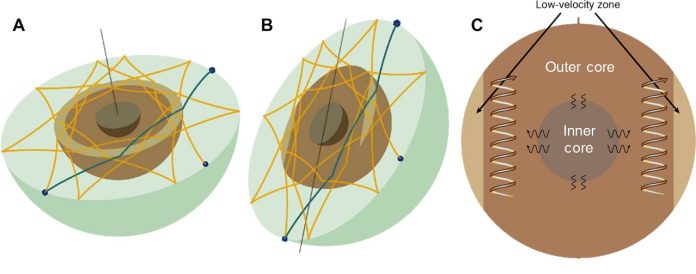
Scientists from The Australian National University (ANU) have made a fascinating discovery deep within the Earth’s core—a doughnut-shaped region that could provide new insights into how our planet’s magnetic field works.
This discovery was made several thousand kilometers beneath the Earth’s surface, within the liquid layer of the outer core.
The Earth’s core is made up of two main layers: a solid inner core and a liquid outer core, both surrounded by the mantle.
The newly found doughnut-shaped structure is located at the top of the liquid outer core, where it meets the mantle. Interestingly, this structure is found only at low latitudes, meaning it sits parallel to the equator and stretches around the planet in a ring-like shape.
Professor Hrvoje Tkalčić, a geophysicist at ANU and one of the study’s authors, explained that the seismic waves, or vibrations caused by earthquakes, move slower in this doughnut-shaped region than in the rest of the outer core.
This difference in speed suggests that the region has a unique composition, possibly containing a higher concentration of light elements.
“We don’t know the exact thickness of this doughnut-shaped region,” said Professor Tkalčić, “but we believe it extends a few hundred kilometers beneath the boundary between the core and the mantle.”
The discovery was made using a new approach to studying seismic waves. Instead of looking at the waves generated by earthquakes within the first hour, the ANU scientists focused on waveforms that appeared many hours after the earthquakes occurred. This allowed them to observe the waves as they traveled through the Earth’s outer core, leading to the discovery of the previously hidden structure.
Dr. Xiaolong Ma, another author of the study, highlighted that this discovery helps solve some of the mysteries surrounding the Earth’s magnetic field. The outer core, made mostly of liquid iron and nickel, generates this magnetic field through the movement of its electrically conductive liquid.
This magnetic field is crucial for life on Earth, as it protects the planet from harmful solar winds and radiation.
Understanding more about the outer core’s composition, including the presence of light chemical elements, is essential for scientists to better grasp the dynamics of the magnetic field.
These light elements, along with temperature differences within the core, play a key role in stirring the liquid in the outer core, which in turn influences the magnetic field.
“Our findings suggest that the slower seismic waves in this region could be due to a higher concentration of light elements,” said Professor Tkalčić. “This is important because the magnetic field is a critical factor for sustaining life on Earth.”
The research team hopes that their discovery will encourage more studies on the Earth’s magnetic field, not only on our planet but also on other planets. The research has been published in the journal Science Advances.
Source: Australian National University.



